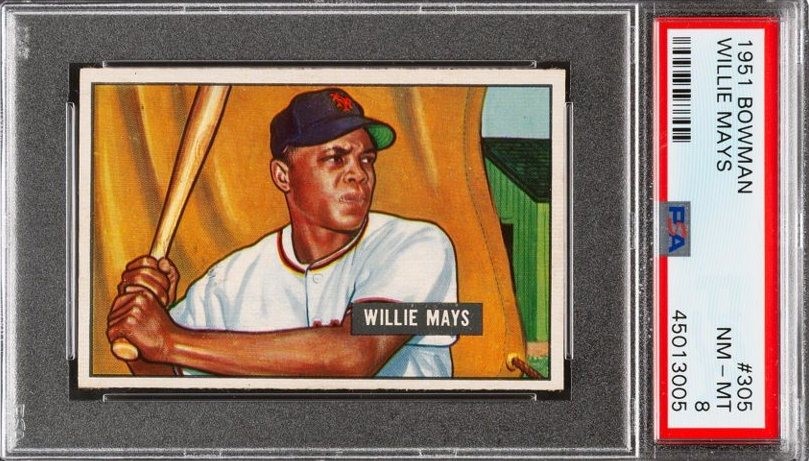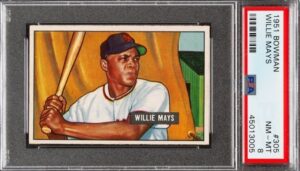By Leila Dunbar | May 8, 2020
The “Say Hey” Kid turned 89 on May 6th. With 660 home runs (in a pre-steroid era), 1903 rbi’s, 338 stolen bases and 12 Gold Gloves (which were not awarded until 1957, Mays’ sixth season), Mays was the epitome of a five-tool player (throw, catch, run, hit for average, hit for power). If he had not missed a season and a half to serve in the Army, he likely would have eclipsed 700 homers and 2,000 rbi’s in his career.
A 1951 Bowman Willie Mays Rookie Card Can Sell From $1,000-$500,000, This PSA 8 Graded Card sold for $48,000 in 2020. Most recently a 1951 Bowman Mantle PSA 8 sold for $111,000 in 2019.
I have always considered Babe Ruth the greatest baseball player of all time because he is the only one who demonstrated he could be both a Hall of Fame pitcher as well as a slugger. The Babe slugged 715 home runs, but also sported a 94-46 record, 2.28 ERA and for many years held the record of most consecutive innings without a run in the 1916 and 1918 World Series (and went 3-0) when he pitched for the Red Sox. Of course, he did not have to hit against himself! And in a minor bit of symmetry, on May 6, 1915, Ruth hit his first home run as a member of the Red Sox.
But this post isn’t about Ruth. I think a case could be made for Mays as the second greatest player. Who else has the same top combination of power, speed and defense? Maybe Barry Bonds, but he will be forever tarnished by steroid allegations. Mike Trout? Too soon in his career, as longevity (avoiding injuries) is a key part of athletic legacy.
Even the great Comet from Commerce, Mickey Mantle, didn’t come close to Mays’ stats and had more support from his team. Yes, the Mick had bad luck stepping on the sprinkler head in the 1951 World Series, was never the same and played four years less.
But Mickey, the country boy who liked the city night life, didn’t take the best care of himself, either. Mays was better longer. And major league scouts marveled at how fast Mays could throw from the pitcher’s mound. So, we will never know what could have been if he had chosen to pitch.
It still galls me that in 1949 the Red Sox turned down buying Mays for $4,500 from his Negro League team the Birmingham Black Barons. Can you imagine Willie in center next to Ted Williams? Institutional racism cursed the Red Sox far more than selling the Bambino to the Yankees in 1919. Maybe the Sox wouldn’t have become such a joke in the 1950’s and 1960’s. It is the ultimate case of cutting off your nose to spite your face.
But, with Mays (plus Monte Irvin and Hank Thompson) the Giants could somewhat keep pace with the Yankees and Dodgers in an era where New York ruled baseball, culminating with the Giants winning the 1954 World Series Championship and Mays winning his first NL MVP award. Furthermore, he captured the public’s attention with his spectacular World Series over the shoulder catch of Vic Wertz’s towering line drive, (known today as “The Catch,”) immortalized through television and the enduring image of Mays today.
When owner Horace Stoneham moved the team to San Francisco for the 1958 season, Mays helped establish major league baseball on the West Coast, winning his second MVP in 1965. The Giants almost had their second World Series win in 1962, but fellow Hall of Famer Willie McCovey’s seventh game, bottom of the ninth inning, two out line drive was snagged by second baseman Bobby Richardson, leaving runners on second and third and preserving the Yankees dramatic one-run and 4-3 Series win.
In general, Mays memorabilia has sold at the same level as some of the other of the post war greats, but not nearly at the Mantle level. In the past five years Mays jerseys have sold from $75,000-$220,000 paid for a 1957 NY Giants jersey, the same general range as Aaron, Sandy Koufax, Yogi Berra and Ted Williams.
Values paid for items largely depend on not only the historical importance end enduring legacy of the player themselves, but also the importance of the event related the object, rarity, authenticity, provenance and the biggest intangible, desirability. World Series and All-Star game related items as well as milestone pieces (500th home run, etc.) are rarer and more important and therefore usually sell for higher prices then regular season related items. Most non Hall of Fame players’ memorabilia sells in the hundreds to low thousands, unless it is tied to a major event (like Kirk Gibson’s bat that he used to hit a walk-off homer against Dennis Eckersley in Game 1 of the 1988 World Series, thus setting the tone for the Dodgers upset win over the A’s. It sold for $575,912 in 2010. Today you can buy a regular season game used Gibson bat for $1,500-$2,000.
Mays bats are a relative bargain, selling from $10,000-$50,000, but none have ever been offered representing his top milestones. Williams bats have sold from $50,000-$200,000 but the higher prices are generally from significant events, such as hitting his 517th home run, which sold for $125,317 in 2017.
Mays’ two rookie cards (1951 Bowman and 1952 Topps) today can sell anywhere from $1,000 to $500,000, depending on the grade (1-10, the higher the better).
Since his 2003 estate sale, Mantle’s game used uniforms, MVP awards, championship rings and bats have sold in the hundreds of thousands of dollars to $1,320,000 paid in 2018 for Mantle’s 1964 World Series Home Run Record Setting Game Worn New York Yankees Jersey. This is where Mantle set the record at 16 career World Series home runs. And his 1952 Topps Rookie Card graded PSA 9, sold for a whopping $2.88 million in 2018, just loony for a piece of manufactured cardboard that some of you put in your bicycle spokes (but some may look at a diamond as just a bit of pressurized carbon, eh?).

1952 Mickey Mantle Topps Rookie Card, PSA 9, $2.88 Million, 2018, Mays PSA 9, Peaked At $478,000, 2016, $245,000 In 2017
Why the difference? Part of it could be that Mantle was the handsome, clean cut (read: non ethnic) All-American boy who played for the Yankees in the world’s epicenter of New York, winning 7 World Series Championships in 11 appearances. He was the symbol of what a part of America wanted it to be; whereas Koufax (Jewish), Aaron and Mays (Black), Berra (Italian) and Williams (half Mexican) were the symbols of what America really was (and is) and important idols to kids who were like them.
1964 Mantle World Series Home Run Record Setting Jersey, $1,320,000, 2018
On the other hand, the market has recognized the culturally transcendent history of Brooklyn Dodger Jackie Robinson’s integration achievements and the tragic altruism of Pittsburgh Pirate great Roberto Clemente. For example, Robinson’s 1947 Rookie Of The Year Award (also the first year it was handed out) sold for more than $402,000 in 2014; and his 1947 rookie jersey from Robinson’s historic season where he broke the major league baseball color line, sold for $2,050,000 in 2017, the second highest auction record (Ruth’s earliest known Yankee jersey from 1920 sold for $4.4 million in 2012).
1947 Jackie Robinson Rookie Of The Year Award, $402,000, 2014
Roberto Clemente’s 1971 Pirates World Series Championship Ring sold for a $381,875 (only second to Ruth’s 1927 ring) and his 1967 National League Silver Slugger Bat Award set a record at $493,500, eclipsing the 2003 record $313,500 paid for Mantle’s 1956 AL SS bat (although that would likely sell for far more on today’s market). Mays 1954 Silver Slugger bat from his 1954 MVP season brought $120,096 in 2003, a third of Mantle’s from his Triple Crown year.
1971 Roberto Clemente World Series Ring, $381,875, 2017
It may simply be that, unlike his compatriots (except for Aaron, who is also still alive) most of Mays’ top game used items and his awards items have not come up for recent sale. Some are also enshrined in Cooperstown, such as Mays’ 512th and 600th home run bats; 3,000th hit bat and two of his Gold Glove awards. Aaron’s 500th, 600th, 716th (which broke Babe Ruth’s career home run record) and 717th home run bats, 1974 Braves Home Jersey worn hitting his 715th home run to tie Ruth’s record; and 1957 Braves World Series Championship ring are there as well. Make sure you visit them when the Baseball Hall of Fame opens back up!
FYI, in his top earning years, Mays made $165,000, for which today you could buy a few mid-grade Mays rookie cards. Today I would think that Mays would likely command $40 million, plus his Nike deal. Who would you rather have; Trout, Machado, Harper, Rendon, Betts (as a lifelong Red Sox fan, that also still hurts.) or Mays in his prime?
Yes, times have changed, but Willie’s place at the top of baseball history remains.







